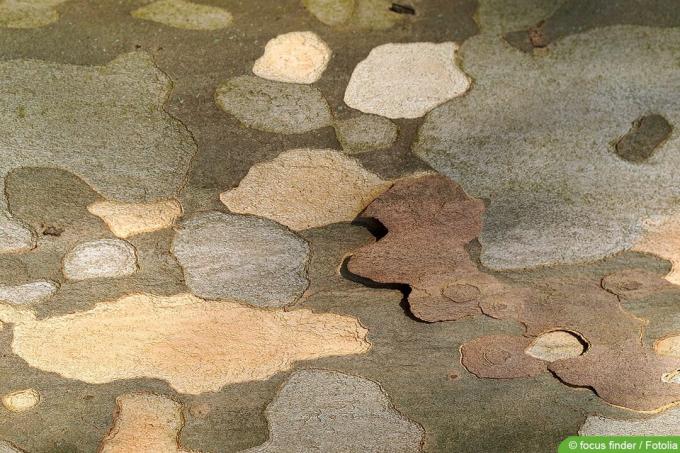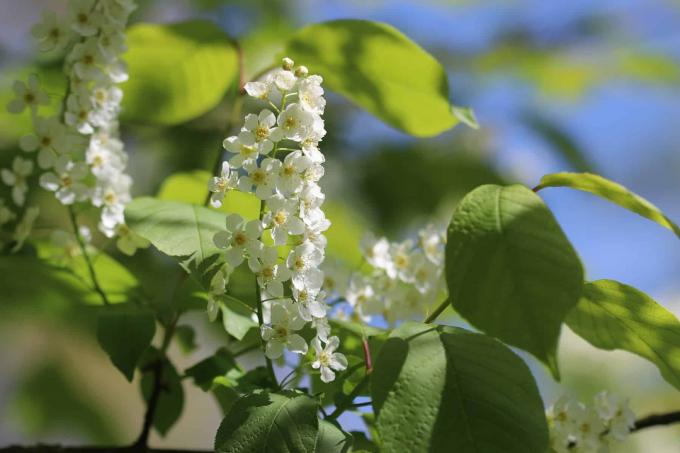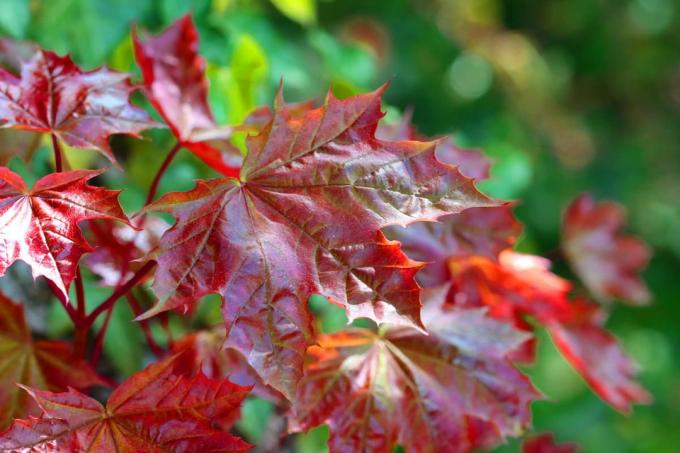

Table of contents
- Characteristics
- Location
- ground conditions
- Best planting time
- Plant properly
- Pour
- Fertilize
- Cut
- Preservation and thinning cut
- topiary
- Training cut as a roof plane
- Standard cut
- hibernate
- multiply
- diseases and pests
- diseases
- pests
- combat
- plane tree varieties
Older plane trees are very easy to care for, but as young plants they need attention in various areas in order to be able to grow and mature healthily. How the right care looks like can be read in the following.
Characteristics
- Botanical name: platanus
- Trivial names: plane tree, roof plane tree
- Origin: from temperate climate zones in Europe, Asia and North America
- Growth width: 15 to 20 meters
- Growth rate: 45 to 60 centimeters per year
- Growth height: 25 to 30 meters
- Flowering time: April to May
- Flower color: yellowish-green
- Foliage: deciduous, variegated autumn foliage, deciduous
- Extremely hardy, young plants sensitive to frost
Location
The basic prerequisite for a healthy, vigorous growth of a plane tree is the right location. It should meet the following criteria:
- Light conditions: sunny, tolerates light penumbra
- Plenty of space for tall and wide growth (at least 4.5 meters laterally)
- Shelters if possible (prone to branch breakage)
- Mild winter regions
- Ideal for providing shade in parks and private gardens
ground conditions
In addition to the optimal location, the soil conditions are also responsible for strong growth and resistance. The plane tree draws energy from this through nutrients and trace elements. In order for the supply to function ideally, certain properties of the ground/earth must be observed:
- Fresh, deep soil (roots deeply as a heart root)
- Gladly loamy and/or sandy if there is sufficient moisture
- Nutritious
- pH value: slightly acidic to alkaline (calcareous)
- Well permeable to water (avoid waterlogging at all costs)
Best planting time
Plane trees are usually offered commercially as container goods. Theoretically, these can be planted all year round. However, spring is the better time, when it is slowly getting warmer and the growing season officially begins. This is because the roots of the new plant are given more time to establish their roots until the coming winter. This allows them to get through the cold season better.

Plant properly
In order to achieve an ideal establishment of the root system, the right approach to planting is necessary. Thats how it works:
- Dig the planting hole twice as wide as the root ball
- Choose the depth of the planting hole so that the bale rests on it and can be covered with soil as high as before in the pot/container
- Enrich excavated soil with compost
- Insert the plant and fill in the planting hole
- Press the soil down well
- If necessary, use a stake as a stabilizer (do not connect with wire or similar - better thicker rope or cord)
- Layer mulch on top of soil around roots – reduces evaporation and releases nutrients slowly
- Water generously and keep slightly moist continuously in the following months (do not let the soil dry out under any circumstances).
Pour
During the first year of planting, a plane tree should be kept slightly moist throughout, without overwatering or even provoking waterlogging. From the second year of planting, the roots have established themselves and the need for water decreases. From now on, plane trees can also tolerate short dry periods. In midsummer it should be watered regularly. The younger specimens in particular need more water than the older plane trees because less moisture can be absorbed in the still short roots.
Tip:
The so-called impact casting is suitable for less work. It is watered vigorously once instead of giving smaller amounts of water several times. The heart root system and deep-seated roots provide ideal water storage after a shock irrigation. Exception: young plants.
Fertilize
Fertilizing is not absolutely necessary for the plane tree. Due to the heart-shaped root spread, the plant reaches other areas of the earth and, accordingly, sufficient nutrients. Mulching every four to six weeks during the growing season is quite sufficient. Grass clippings, for example, are ideal for this. A layer of bark mulch in autumn provides additional protection against the cold and also releases nutrients into the soil in the following year as it rots.
Cut
Plane trees are very tolerant of pruning. If they are not cut, they grow immensely in height and width. In addition, this will one day lead to sprawling crowns that are not considered attractive for everyone. In principle, garden experts recommend pruning. Various cutting techniques can be used:
Preservation and thinning cut
With the maintenance and thinning cut, old and dried out branches are cut off. Especially inside the tree (especially in the crown), branches should be removed if too dense growth inhibits air circulation and thus increases the risk of fungal infections. The pruning is carried out on plane trees between October and February. It promotes the formation of new shoots and holds crowns together better.
topiary
In summer, when the bloom is over, the perfect moment for a topiary has come. If you want to call a distinctive roof or spherical plane tree your own, start with the topiary between June and the beginning of August. It should not be pruned later, as growth slowly slows down from September and regrowth does not take place in the correct form. If an existing shape is to be trimmed, this can also be done during the winter months and done together with the thinning cut. It is important to pay attention to the flower buds that have already formed, so that they do not fail to flower in the next flowering season.
A NOTICE:
At the beginning of autumn, when the temperatures slowly drop and the humidity rises, it is important for Only dry days should be selected for cutting so that the cuts can dry well. Otherwise there is an increased risk of fungal infestation.
Training cut as a roof plane
Educational cuts as so-called roof sycamores are very popular. The point is to cut and "train" the branches in such a way that it appears like a flat roof, similar to a parasol. This is the correct way to do it:
- Remove all vertical shoots
- Trim down branches where the bend begins
- Shorten the main branches as much as possible to encourage the growth of new shoots
- Pruning twice a year: before St. John's Day (24. June) and again at the end of August
Standard cut
Plane trees can be further shaped by pruning them from the trunk. It works like this:
- Cut off all side shoots on the trunk
- Young shoots before 24. Cut back in June and late August
- Shorten main shoots only between October and February (promotes dense crown formation)
Tip:
When the leaves are cut, they lose their fine hairs. These can trigger an allergy. Therefore, mouth and nose protection should always be worn when cutting.
hibernate

Plane trees are extremely hardy and tolerate temperatures well below minus 20 degrees Celsius. Only the younger specimens are sensitive to frost in the first three to four years because their roots do not yet reach deep into the earth where frost cannot harm them. They need a cold protectant layered onto the soil surface over the root area. The following are particularly suitable for this:
- Special fleece
- straw
- leaves
- brushwood
- pine needles
multiply
The plane tree is usually a hybrid plant that cannot be propagated by seeds. Therefore, only the cuttings method is suitable for propagation. With the following instructions it works without any problems:
- Best time: autumn, before cold temperatures cause frost
- Choose the optimal shoot: should be at least one year old shoot, is slightly woody and between 20 and 30 centimeters long
- Remove leaves and side shoots in the lower third of the shoot
- Put the cuttings halfway into a sandy and nutrient-poor substrate
- Moisten slightly and leave to "rest".
- Location: bright, cool, but frost-free
- Pull out of the substrate in March and place in loosened garden soil (may only protrude five centimeters from the soil)
- Keep soil continuously moist
Tip:
Plane trees are also suitable for cultivation in tubs, especially in the course of propagation. Due to the limited space, they remain in a "manageable" size and can be kept to the desired dimensions by cutting back. Here you just have to make sure that a deep bucket is available.
diseases and pests
A plane tree is a very robust and resilient plant. However, diseases or pest infestation cannot be completely ruled out. They can usually be traced back to suboptimal care. Most commonly plane trees are affected by the following
diseases
-
tree cancer – triggered by fungal or bacterial infection
Combat: Remove affected bark and branches over a large area -
Massaria disease – fungal disease (Splanchnonema platani)
Combat: not possible
pests
- gall mites (Eriophyidae)
- leaf miners (Gracilariidae)
- sycamore bugs (Corythucha ciliata, synonyms: Tingis ciliata, Tingis hyalina)
- Vine mealybugs (Bohemian mealybug Heliococcus bohemicus or maple mealybug Phenacoccus aceris)
combat
- Make soapy water (dissolve soft soap or curd soap in water until the color becomes cloudy)
- Add one teaspoon of baking soda per liter of water
- Fill into a spray container or pressure gun
- Spray the affected plane tree until dripping wet
- Repeat every two to three days for about two weeks
- Finally, spray the tree well with clear water to remove baking soda and washing-up liquid residue and any pests that are still attached
plane tree varieties
There are different varieties of plane trees. They do not differ in terms of care, but visually and in their growth they can present themselves differently than the classic plane tree. The most popular varieties include:
'Tremonia'
- Pyramidal growth
- Growth height: up to 20 meters
'Alphen's Globe'
- spherical plane tree
- Growth height: maximum five meters
'Suttneri'
- Rare specimen due to its special breeding form
- Growth height: up to 20 meters
- Foliage white, sometimes variegated
- Half-open, wide treetop
 garden editorial
garden editorial I write about everything that interests me in my garden.
Learn more about Baumlexikon

Bird cherry, Prunus padus: caring for, pruning & propagating
The bird cherry is a shrub or tree that is the ideal bee pasture in a natural garden. However, the plant should also be viewed with caution, as it is a poisonous plant for horses. Nevertheless, it is popular in the local colorful hedges.

Red maple: 9 tips for caring for, cutting & overwintering
The red maple is one of the most impressive trees in Germany due to its unusual scarlet leaf colour. Here you can find out how to integrate this impressive plant into your garden and how to keep it healthy and vigorous.

Birch locations: 5 important criteria
Birch trees are extremely frugal trees and are particularly eye-catching and decorative thanks to their light-colored bark. When choosing a location, however, a few factors should be considered in order to create optimal conditions for their growth and to protect the environment.

Cutting dwarf pine - instructions for the perfect cut
Dwarf pines can be pruned by thinning out, topiary or limbing. A bonsai design with needle and root pruning is also possible. So that the wood does not look unattractive after the pruning measure, a few rules of technology should be observed.

Is the vinegar tree poisonous? | Who is it dangerous for?
In ornamental gardens, the vinegar tree is an attractive eye-catcher due to its unusual flowers and the appealing autumn color of its feathered leaves. The red, upright fruit cobs (flowers) are responsible for the striking appearance. Despite everything, the vinegar tree is not an unproblematic tree.

Vinegar, Rhus typhina | Care from A – Z
The vinegar tree is an easy-care plant for the garden and tub with a special autumn color. Only its uncontrolled spread can lead to problems in the garden. However, this can be curbed with a root barrier.
